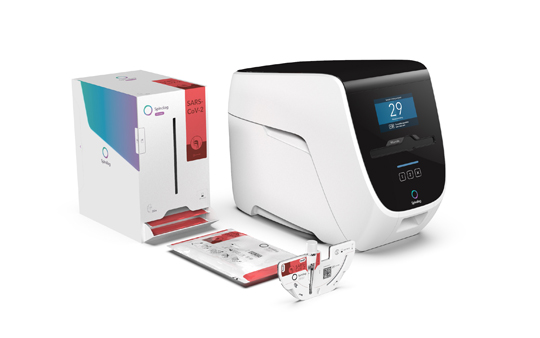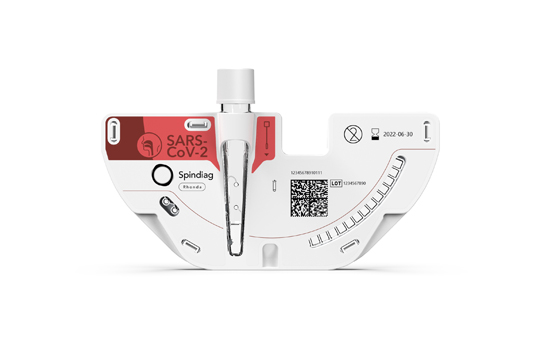Proof of Corona in 35 Minutes
Freiburg, Apr 21, 2020
Quick, uncomplicated and foolproof: the test system of Spindiag GmbH should provide proof of the coronavirus Sars-CoV-2 in 30 to 40 minutes. This rapid test is due to be licensed and available as early as the third quarter of 2020. To achieve this, the team is modifying a test principle which has already worked on other pathogens, to handle Sars-CoV-2. The Federal State of Baden-Württemberg is providing six million euros funding for the project, which is run by Spindiag and the Hahn-Schickard-Institut für Mikroanalysesysteme. The test system originated from this institution and the University of Freiburg’s Department of Microsystems Engineering (IMTEK).
 The Spindiag spin-off wants to produce easy-to-use, rapid corona tests consisting of a plate and an analytical device. Photo: Spindiag GmbH
The Spindiag spin-off wants to produce easy-to-use, rapid corona tests consisting of a plate and an analytical device. Photo: Spindiag GmbH
“It’s full steam ahead,” declares Spindiag CEO Dr. Daniel Mark. “We’ve already shown that our test system can provide evidence of the Sars-CoV-2 gene.” Proof of other pathogens and genes using the rapid test was previously possible. To modify it for Sars-CoV-2, Spindiag simply had to change biochemical details. So Mark estimates that they will be able to ship the first test sets in the third quarter of 2020. “The chances are extremely good,” agrees Prof. Dr. Roland Zengerle of IMTEK at the University of Freiburg. The technology is rooted in his application development work group. The Federal State of Baden-Württemberg also rates the prospects of success as good: it is providing six million euros in funding to Spindiag GmbH and the Hahn-Schickard-Institut für Mikroanalysesysteme for development of the rapid corona test. The University of Freiburg is involved in this project through subcontracts.
Preliminary trials in hospitals delivering excellent data
Explaining his confidence, Zengerle says, “We’ve already analyzed and proven other corona variants with the system.” Spindiag GmbH was a spin-off from his Chair of Application Development and the local Hahn-Schickard-Institut für Mikroanalysesysteme in 2016, and five of its six founders graduated from the Faculty of Engineering. “We’ve received excellent data from all three hospitals that have used our test system in preliminary trials,” reports Mark. These were mainly designed to identify patients who were bearers of bacteria with multiple antibiotic resistance. However only minimal changes were needed to prove Sars-CoV-2.
Mark shows a crescent-shaped plate, “The heart of our technology.” It’s about one centimeter thick and barely any larger than half a CD. Each plate has an integrated swab. Nurses use this to take samples. They take smear tests from a patient’s nose or throat, then push the swab back into the plate, place it into an analytical device, press start and – it’s done. “It’s so easy to use that nurses can do everything on their own,” says Mark. The device processes the sample, shows the result of the test and automatically sends it to the hospital information system. And within no more than 40 minutes the electronic patient files can show: positive or negative for Sars-CoV-2.
 The crescent-shaped plate is the heart of the technology: each plate has an integrated swab which nurses can use to take a sample. Photo: Spindiag GmbH
The crescent-shaped plate is the heart of the technology: each plate has an integrated swab which nurses can use to take a sample. Photo: Spindiag GmbH
Decades of experience on a plate
The ease of use and outward simplicity of the plate is deceptive. The system contains decades of experience and high-tech relating to centrifugal microfluidics. “It’s a clearly-defined field of microfluidics, which I’ve been involved in for 30 years,” says Zengerle. Microfluidics researches the laws controlling the movement of liquids through microchannels. The behavior of a liquid here differs fundamentally from how it acts in a garden hose.
Centrifugal microfluidics also involves rotation: The device rotates the plates at up to 50 revolutions per second. Centrifugal force propels all the other processes. “A test for Sars-CoV-2 consists of more than 30 individual steps,” explains Zengerle. The heart of the plate is an ingenious network of empty microchannels and microchambers, which are partly filled with microquantities of reagents, that is certain chemical substances. First the sample mixes with a preparatory liquid on the plate. This mixture flows through further microchannels. Microchambers open up in a controlled way, so that the reagents always come together at the right time in the right concentration.
Production lines ready
At the end is the actual evidence, a “nested PCR”. This is the term for an intricate chain reaction of the enzyme polymerase. The nested PCR functions rather like an Internet search engine. But in its case it hunts through all the DNA contained in a sample. Primers serve as the “search term”; they fit precisely and only with the gene or organism that is being sought. “We pretty much only had to appropriately exchange the primers for Sars-CoV-2,” says Mark. Following the results of the first search, there is also a second search with a new “search term”, that is, a primer. This considerably reduces the risk of false results. Modification went quickly, the CEO says, “The 2,000 to 3,000 tests of safety and reliability that are needed for licensing took far more time.” Spindiag has already set up production lines to be able to produce thousands of test sets. “We’ve worked hard on our preparations,” says Mark, “Now we’d need an undertaking whether the Federal State will actually buy our test sets and how many.”
Innovation needs investment
Three million euros have been poured into the pilot line alone, Zengerle reports, “We’ve built an additional new clean room so that we can manufacture the sets.” His work group uses centrifugal microfluidics for many other applications. With a “liquid biopsy” they filter rare cancer cells, for example, from blood and urine samples, to enable early diagnosis. Zengerle praises the engagement of Hahn-Schickard, who he also works for part-time, “If we want to bring innovations from the university laboratory into the hospital, we need application-oriented development and appropriate investment.” Some of this came directly from Hahn-Schickard. In addition, public funds, for instance from the Federal State, are easier to attract through the non-profit company. “Hahn-Schickard also funds a professorship in computer science at the University of Freiburg, has around 80 employees on the university campus and now wants to invest 40 million euros in an additional building at the airport,” lists Roland Zengerle. “We’re delighted that the university enables us to do this.” If the corona test is a success, the cooperation will pay off financially for the university through license income.
Jürgen Schickinger
Report on the Spindiag GmbH test system

